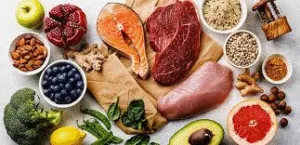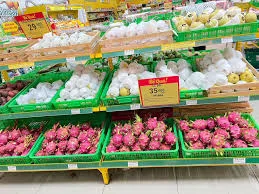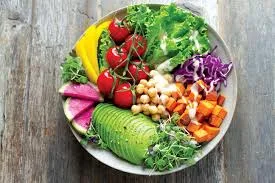-
×
 Organic Malabar spinach 300g 1 × 24 $
Organic Malabar spinach 300g 1 × 24 $ -
×
 Chicken wings 1 × 30 $
Chicken wings 1 × 30 $
News
Leading the Next Decade: Innovations in Clean Food Retail and Customer Experience
The relationship between people and their food is changing faster than ever. Customers want more than just clean ingredients; they demand hyper-convenience, instant information, and a shopping experience that feels personalized and effortless.
Here at Pureluis, we view technology not as an added feature but as the foundational tool for building deeper trust and convenience. This guide outlines our vision for the next decade—the specific innovations we are prioritizing to lead the clean food retail space and secure our promise of quality and simplicity.
1. The Innovation Mandate: Why Standing Still is Not an Option
Innovation for Pureluis is not about being flashy; it’s about solving the customer’s toughest problems: lack of time, fear of food waste, and lack of clarity.
1.1. Defining the Future of the Clean Food Customer Experience (CX)
The best customer experience should feel invisible. The ideal clean food CX should:
- Anticipate Needs: Know what the customer wants before they even open the app.
- Erase Friction: Make the ordering and checkout process instant.
- Validate Trust: Provide instant, verifiable data on every product’s origin and freshness.
1.2. The Pureluis Investment Philosophy (Innovation for Trust)
Every dollar invested in technology must directly strengthen the customer’s trust in our clean sourcing model. If an innovation doesn’t make food safer, the supply chain faster, or verification easier, we won’t pursue it. Our innovation is disciplined, driven by integrity and efficiency.
2. E-commerce Technology: Creating the Seamless Digital Kitchen
The future of clean food shopping is driven by artificial intelligence (AI), predictive modeling, and instant access across all digital platforms.
2.1. AI and Predictive Shopping (Anticipating the Customer Cart)
We are moving past static recommendation engines and towards an AI that acts as the customer’s personal, highly intelligent grocery assistant.
2.1.1. Dynamic Meal Planning Integration (The Automated Grocery List)
The AI will track the customer’s dietary preferences (Keto, Vegan, etc.), recent purchases, and common cooking patterns.
- The Feature: A dynamic, one-click button that generates a 7-Day Clean Meal Shopping List based on items currently on sale and the customer’s past preferences. This eliminates the planning stress entirely and is the ultimate expression of convenience.
- The Benefit: It ensures the customer buys only what they need, reducing food waste and making the shopping trip effortless.
2.1.2. Voice Ordering and Smart Home Integration
As smart home devices become ubiquitous, ordering should happen through voice command.
- The Future: Customers will be able to say, “Pureluis, re-order the usual eggs and spinach,” or, “Pureluis, add chicken to my cart,” directly through their smart speaker. This moves ordering from an intentional chore to a background task, capturing sales the moment the customer realizes they are out of a staple.
2.2. Visual Commerce and Transparency Tools
Customers trust what they can see. Technology will bring the farm directly to the digital storefront.
2.2.1. 360-Degree Product Viewing and Virtual Farm Tours
- Enhanced Product Pages: High-resolution, zoomable 360-degree views of every produce item will be standard, allowing customers to digitally verify quality before purchase.
- Virtual Trust: The Batch ID (our traceability code) will link not only to data but to short video snippets or a virtual tour of the specific farm location where that product was grown. This is the ultimate proof of our clean sourcing promise.
2.3. Hyper-Personalized Communication (Beyond Email)
Communication will be personalized not just by name, but by context and timing.
- App Notifications: Instead of email marketing, personalized alerts will be sent directly through the Pureluis app only when relevant (e.g., “Your favorite heirloom tomatoes are back in stock for 48 hours,” or “Your scheduled delivery is leaving the hub now”). This respects the customer’s time and drives high engagement.
3. Product and Service Innovation: Solving the Busy Person’s Problem
We must anticipate the customer’s struggle to cook clean food quickly and efficiently. Our product innovation focuses on minimizing prep time and maximizing success in the kitchen.
3.1. The Ready-to-Cook (RTC) Evolution
The market demands simple, clean meals that require zero chopping and minimal cleaning.
3.1.1. Advanced Portioning and Ingredient Kits
- The Feature: Offer meal kits that contain all the verifiable Pureluis ingredients, pre-washed, pre-chopped, and perfectly portioned (e.g., “Clean Chicken Stir-fry Kit”). Crucially, these kits must only contain clean ingredients and simple seasonings, adhering strictly to the clean eating philosophy.
- The Goal: Reduce the “time to table” for a clean meal to under 15 minutes, directly competing with the convenience of unhealthy takeout.
3.2. Clean Food Subscription Boxes (Targeted and Flexible)
Subscriptions should be flexible, intelligent, and aligned with dietary goals.
- The “Zero Waste Box”: A subscription that focuses on seasonal, locally sourced produce chosen by the Pureluis sourcing team. The box is explicitly designed to minimize transport and food waste by utilizing the best ingredients harvested that week.
- The “Diet Goal Box”: Pre-curated weekly boxes targeting specific health objectives (e.g., “High-Protein Recovery Box,” “Low-Carb Essentials Box”), automating clean eating compliance.
3.3. Health Integration and Data Sharing
The future of grocery shopping connects to the future of personal health management.
- API for Health Apps: Develop an open Application Programming Interface (API) that allows customers to securely share their Pureluis purchase data with their preferred nutrition tracking apps (e.g., MyFitnessPal, etc.). This makes logging food intake instantaneous and verifies the quality of the ingredients used. This seamless data sharing reinforces our position as a health-focused brand.
4. Operational Excellence: The Final Frontier of Freshness
The greatest innovations often happen behind the scenes, ensuring the cold chain is never broken and delivery is instant and predictable.
4.1. Next-Gen Cold Chain Technology
Maintaining the integrity of fresh food from the farm to the kitchen is the most essential operational challenge.
4.1.1. Smart Packaging and Temperature Monitoring Alerts
- IoT Packaging: Integrate small, disposable temperature sensors into every insulated delivery box. This sensor records the temperature of the contents throughout the delivery journey.
- Customer Trust: Upon arrival, the customer can scan a QR code on the box to view the temperature log for their specific order, providing real-time, undeniable proof that the cold chain was never broken. This transparency builds ultimate trust in product safety (referencing our Traceability efforts).
4.2. Autonomous and Sustainable Last-Mile Delivery
We must strive for delivery that is low-emission, fast, and highly predictable.
- Optimized Routing: Utilize advanced AI routing systems that dynamically adjust delivery paths based on real-time traffic and weather conditions, guaranteeing narrow, reliable delivery windows (e.g., 15-minute windows instead of 2-hour blocks).
- Low-Emission Fleet: Continue the transition toward an entirely low- or zero-emission fleet (electric vehicles, e-bikes) for urban areas, reinforcing our commitment to Environmental Stewardship (Section 4.1).
4.3. Micro-Fulfillment Centers (Speed and Efficiency)
We are moving away from massive, centralized warehouses toward a network of smaller, strategically placed Micro-Fulfillment Centers (MFCs) closer to dense urban customer bases.
- The Advantage: MFCs drastically cut the “time to delivery,” allowing for same-day delivery promises and minimizing the environmental impact of transport. By reducing the time between order placement and delivery, we maximize the freshness and usability of the product when it reaches the customer.
5. Conclusion: Innovating for a Healthier Tomorrow
Innovation at Pureluis is not just about adopting new technology; it’s about applying the best tools available to solve the problem of living a clean, healthy, and convenient life. By focusing our investments on AI-driven personalization, verifiable transparency tools, and highly efficient logistics, we are building the future of clean food retail—a future where trust is absolute and quality is never compromised.
6. The Integrated Feedback Loop: Using Data to Design the Future CX
True innovation doesn’t happen in a vacuum—it happens when you listen deeply to your customers and your operational data. Our future Customer Experience (CX) will be designed by a sophisticated, integrated feedback loop that constantly learns, adapts, and improves.
6.1. Advanced Data Collection and Warehousing
Before we can listen, we must collect the right data and house it in a structure that allows for rapid analysis.
6.1.1. Unifying Data Streams (The Data Warehouse)
We must break down the data silos between our systems: the e-commerce platform (purchases), the logistics platform (delivery times/temperatures), and the customer service system (complaints/feedback). All this data will be fed into a single Data Warehouse.
- The Goal: This unification allows us to ask complex questions, such as: “Do customers who experience a delivery delay of over 30 minutes purchase less meat the following week?” The answer drives actionable change in the logistics strategy.
6.1.2. Automated A/B Testing for UX/UI

Continuous A/B testing is crucial for ensuring the digital experience remains effortless (Section 2).
- The Process: Implement an automated testing system that constantly tests small variations (e.g., color of the “Buy Now” button, placement of the Traceability link, different checkout flow) against key performance indicators (e.g., conversion rate, cart abandonment). This ensures every change is data-driven and improves customer convenience.
6.2. Voice of the Customer (VoC) Analysis
We must move beyond simple surveys to analyze unstructured data—what customers say and write about us.
6.2.1. Analyzing Customer Service Logs with AI
Customer service transcripts and chat logs contain direct insights into pain points. We will deploy Natural Language Processing (NLP) AI to scan thousands of these logs daily.
- The Benefit: The AI can quickly identify emerging trends (e.g., a sudden increase in complaints about “mushy broccoli” or “fish packaging smell”) before human agents flag them. This leads to predictive quality control—allowing us to alert the broccoli supplier before the issue becomes widespread.
6.2.2. Measuring Net Promoter Score (NPS) with Actionable Follow-Up
NPS measures loyalty (“How likely are you to recommend Pureluis?”). The key is to immediately act on the low scores.
- The Follow-Up: Every customer who gives a low score (“Detractor”) must receive an immediate, personalized follow-up from a senior customer service agent (not an automated email). The goal is to understand the root cause, fix the issue, and try to convert the Detractor back into a “Promoter.” This high-touch intervention is a powerful loyalty builder.
6.3. Predictive Maintenance and Operational Data
Data collected during operations should be used not just to report a problem, but to prevent one.
6.3.1. Predictive Fleet Maintenance
Sensors in our delivery vehicles will track performance metrics (engine temperature, battery health, refrigeration unit function). AI analyzes this data to predict when a vehicle component is likely to fail.
- The Result: We can schedule maintenance before a breakdown occurs, eliminating delivery delays caused by faulty equipment, and thus protecting the Last-Mile CX (Section 4.2).
6.3.2. Automated Sourcing Alerts
Integrate supply chain data (weather forecasts, supplier compliance scores, recent quality failures) into a dashboard that provides proactive risk alerts. If a supplier’s compliance score drops below a threshold and local weather predicts a flood, the system automatically alerts the sourcing manager to find an alternative for that crop. This uses data to ensure supply resilience.
7. Future Tech Integration: Applied Robotics and AI in the Supply Chain
While our customer interaction is high-touch, our internal operations must be high-tech. Integrating robotics and advanced AI into our Micro-Fulfillment Centers (MFCs) and logistics will guarantee freshness, speed, and safety at scale.
7.1. Micro-Fulfillment Center (MFC) Automation
MFCs (Section 4.3) are the heart of our speed strategy. Automating key functions ensures rapid, accurate, and safe order fulfillment.
7.1.1. Robotics for Picking and Packing
Robotic systems will be deployed to handle the high-volume, repetitive tasks of picking standardized dry goods and packaged items.
- Benefits: This increases picking speed (faster delivery), reduces human error (more accurate orders), and frees human workers to focus on the delicate task of quality checking and hand-selecting fresh produce—where the human eye and touch are irreplaceable.
7.1.2. Automated Temperature Zoning and Storage
MFCs will utilize automated storage systems that place every product category (meat, dairy, produce, frozen) into the exact optimal temperature zone.
- Verification: The system constantly logs temperature in every zone. If a zone deviates even slightly from the required temperature, an alert is triggered, and the affected products are quarantined automatically. This provides an unmatched level of safety and integrity to the cold chain.
7.2. AI for Quality Control and Predictive Spoilage
AI is transitioning from being a tool for marketing to a tool for physical quality control.
7.2.1. Computer Vision for Produce Grading
As fresh produce arrives at the MFC, it will pass under Computer Vision systems (high-speed cameras and AI software).
- The Check: The AI is trained to recognize subtle defects (small bruises, discoloration, surface blemishes) invisible to the human eye. This system instantly rejects produce that does not meet the high Pureluis standard, ensuring only the freshest, highest-quality items make it into the customer’s box.
7.2.2. AI-Driven Predictive Shelf Life
Using data from the Batch ID system (harvest date, transport temperature, and farm location) and data from the Computer Vision system, AI can calculate a highly accurate, personalized “true shelf life” for every item.
- Application: This predictive data informs the packer which specific crate of apples should be picked for a customer who is scheduled for delivery in 12 hours versus one scheduled for delivery in 48 hours. This ensures every customer receives produce with the maximum possible freshness window, virtually eliminating in-home spoilage.
7.3. Next-Gen Inventory Management: Dynamic Demand Forecasting
AI will optimize inventory to prevent stock-outs and reduce food waste (Section 2.3).
- Predictive Ordering: AI analyzes historical purchase data, real-time weather forecasts (e.g., buying more chili ingredients before a cold snap), and external trends (e.g., social media mentions of specific recipes) to generate hyper-accurate forecasts for sourcing managers.
- The Impact: This means we order the exact amount of fresh produce needed, drastically reducing the excess inventory that typically leads to food waste in conventional retail, reinforcing our commitment to sustainability.
These advanced technological and data-driven systems are the backbone of the next generation of clean food retail, allowing Pureluis to deliver on its promise of unparalleled quality, transparency, and convenience.
8. Human-Centric Innovation and Cultural Alignment (The People Factor)

In the rush toward AI and robotics, it is easy to forget that grocery shopping is fundamentally a human interaction built on trust. Our final pillar of innovation focuses on using technology to empower our people, making every human touchpoint—from the customer service agent to the delivery driver—an opportunity to reinforce the Pureluis promise.
8.1. Empowering the Delivery Team: The Last-Mile Ambassadors
The delivery driver is often the only human face the customer sees. They are our most critical brand ambassadors.
8.1.1. Technology for Empathy, Not Just Efficiency
Our delivery app is designed to provide drivers with hyper-localized context about the customer. For example, the app can alert the driver: “This customer lives on the 4th floor, is usually home after 5 PM, and has ordered frozen fish—prioritize a fast hand-off.”
- The Goal: This data allows the driver to personalize the final interaction, making the experience feel curated and attentive, not just transactional.
8.1.2. The “Clean Check” Protocol
We use the delivery team as the final quality control layer. Before handing over the insulated box, the driver is prompted via their device to confirm the external integrity of the packaging and temperature indicators. This simple, final check reinforces to the customer that Pureluis standards are maintained right up to the final second.
8.2. Hiring for a Customer-Centric Culture
Innovation starts with the people we bring into the company—people who are naturally driven by the mission of clean food and customer well-being.
8.2.1. Mission-Aligned Hiring and Training
Our hiring process prioritizes candidates who demonstrate a genuine passion for health, cooking, and sustainability, not just those with e-commerce experience.
- The Sourcing Manager: Must genuinely care about the farmer’s welfare.
- The Customer Service Agent: Must genuinely understand the difference between Best By and Use By dates. We train our teams not just on process, but on the why—the importance of the Source Story and the integrity of the Cold Chain.
8.2.2. Utilizing AI to Free Up Human Expertise
We use AI for the mundane, repetitive tasks (like answering “Where is my order?” or flagging simple issues) so that our human experts in customer service can focus their time on complex, high-value interactions (like resolving a product issue, managing a sensitive complaint, or providing in-depth nutritional advice). This ensures human expertise is always applied where it builds the most loyalty.
8.3. The Innovation Incubator: Ideas from the Front Lines
The best ideas often come from the people interacting with the customer or the product every day. Our structure must formalize this feedback.
8.3.1. The Cross-Functional Innovation Task Force
We establish a permanent task force with representatives from all core functional areas: Customer Service (knows the complaints), Logistics (knows the physical limitations), and Sourcing (knows the product).
- The Mandate: This group meets monthly, empowered to propose and pilot small, quick innovations based directly on the integrated operational and customer data (Section 6). This prevents organizational silos from slowing down progress.
8.3.2. Rewarding Improvement, Not Just Sales
The compensation structure must incentivize positive customer outcomes. We tie bonuses for delivery teams, packers, and customer service agents not just to raw sales numbers, but to metrics that directly reflect the quality of the CX: NPS scores, low DSR (Damage/Spoilage Rate), and high Traceability Look-Up Rates (TLR). This ensures that the entire organization is financially aligned with the mission of building trust and providing superior service.
This final, human-centric focus ensures that as Pureluis integrates advanced technology, it never loses sight of the core relationship of trust—the essential ingredient that makes every customer a loyal member of our community.
9. The Holistic Customer View: Unifying the Digital and Physical CX
All the technology, the training, and the operational excellence we have discussed must serve a single purpose: ensuring the experience of the actual, physical product precisely matches the digital promise of quality and convenience.
9.1. Seamless Integration of the Clean Promise

The Pureluis brand must feel like a single, consistent entity across all channels.
- The Digital Mirror: The Computer Vision system that graded the freshness of the broccoli upon arrival at the MFC (Section 7.2) is the digital mirror of the physical broccoli the customer receives. If the AI graded it as perfect, and the customer receives a bruised product, the system has failed.
- Validation at the Door: The Smart Packaging Temperature Log (Section 4.1) validates the online promise of Cold Chain Integrity. The digital data confirms the physical reality, completing the trust loop.
9.2. Closing the Loop on Personalization
Personalization should follow the customer from the screen to the kitchen.
- The AI-Informed Packer: The AI that predicts the customer’s favorite recipes (Section 2.1) should also inform the physical packing team. A customer who consistently orders ingredients for a certain recipe might find a small, personalized recipe card for that dish included in their box, alongside a handwritten note from the packer (Section 8.1). This simple, low-tech addition, informed by high-tech data, creates a memorable moment of human connection.
- Proactive Problem Solving: If the AI predicts an ingredient substitution is necessary due to a sudden shortage, the notification shouldn’t just be an email. The delivery driver (Section 8.1) should have a pre-loaded, personalized note on their device to apologize for the substitution and explain the ethical reason (e.g., “We substituted the spinach because the audited farm reported unexpected heavy rain, and we refuse to compromise on quality”).
9.3. The Ultimate Goal: A Brand That Works for You
The ultimate objective of our innovation strategy is to make clean eating the easiest, most trustworthy choice available. The customer should feel that Pureluis understands their needs, respects their time, and manages the entire complex process of clean sourcing invisibly and reliably. When the digital convenience meets the physical integrity of a truly clean product, you secure not just a sale, but a lifelong advocate.

 Organic Malabar spinach 300g
Organic Malabar spinach 300g  Chicken wings
Chicken wings 